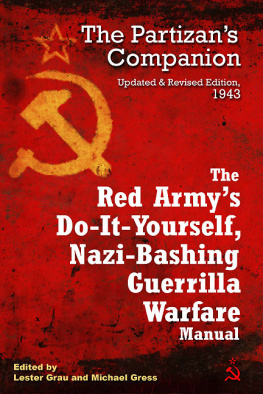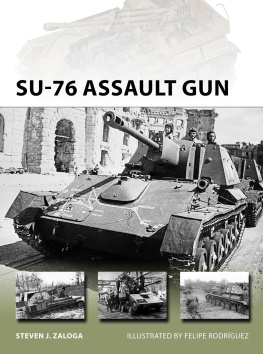

Published in the United States of America
and Great Britain in 2011 by
CASEMATE PUBLISHERS
908 Darby Road, Havertown, PA 19083
and
17 Cheap Street, Newbury RG20 5DD
Copyright 2011 Lester Grau and Michael Gress
ISBN 978-1-61200-009-1
Digital Edition: ISBN 978-1-61200-020-6
Cataloging-in-publication data is available
from the Library of Congress and the British Library.
All rights reserved. No part of this book may be reproduced or transmitted in any form or by any means, electronic or mechanical including photocopying, recording or by any information storage and retrieval system, without permission from the Publisher in writing.
10 9 8 7 6 5 4 3 2 1
Printed and bound in the United States of America.
For a complete list of Casemate titles please contact:
CASEMATE PUBLISHERS (US) Telephone (610) 853-9131,
Fax (610) 853-9146 E-mail: casemate@casematepublishing.com
CASEMATE PUBLISHERS (UK) Telephone (01635) 231091,
Fax (01635) 41619 E-mail: casemate-uk@casematepublishing.co.uk
FOREWORD
The June 1941 German invasion of the Soviet Union caught the Soviet leadership unprepared. As the remnants of the Red Army staggered back toward Moscow, the German forces swept over the Soviet countryside, capturing thousands of square miles of Soviet countryside. There was little to stop them. The Soviet Union desperately threw half-trained soldiers in their path while they looked for other ways to slow the Fascist invader. One possible weapon was guerrilla forces. While the Soviet leadership espoused guerrilla war, they did not want the common people to rise against the Germans. Even in these perilous times, the Soviet government wanted control. The Soviet answer was not to employ locals. Rather they quickly formed army reservists, party activists and secret police into partisan detachments and sent them into the German-occupied areas. Unfamiliar with the local area, surrounded by the enemy, and short on food and equipment, these initial detachments accomplished little, and few survived.
In 1942, when the Soviet Union decided to expand partisan war to incorporate the local Soviet citizens now living under German occupation, they did so while also extending Soviet control over the guerrillas. Military officers were assigned to lead the guerrilla bands. Military discipline was extended over the bands, and they were reorganized into squads, platoons, companies and battalions. A central partisan staff provided command and control over the guerrillas from Moscow. The partisans were trained to a common standard. Communist Party organizations were reintroduced, and the secret police watched the Germansand the partisans.
By 1943, it was obvious that Germany was losing the war. The partisan ranks swelled as did the training requirements for the partisan commanders. This 1943 edition of the Partisans Companion helped train the new guerrillas to a common standard in a hurry. It is an interesting document that covers partisan tactics, German counter-guerrilla tactics, demolitions, German and Soviet weapons, scouting, camouflage, anti-tank warfare, anti-aircraft defense, defense against a chemical attack, hand-to-hand combat, first aid, field living and winter survival. It can be read by individual partisans, but is really designed for squad and platoon-level instruction. This handbook contains the Soviet lessons of two bitter years of war and provides a good look at the tactics and training of a mature partisan force. It is geared to the partisan detachment (battalion) and smaller units. The partisans already were men and women who were expected to be reasonably self-sufficient, capable of making simple repairs and constructing their own shelter, camp ware, skis, snowshoes, and sleds. Their units were supposed to move and live clandestinely, harass the enemy, and support the Red Army through reconnaissance and attacks on the German supply lines. They were also the agents of Soviet power and vengeance in the occupied regions.
Soviet historians credit the partisans with tying down ten percent of the German army and with killing almost a million enemy soldiers. They clearly frustrated German logistics and forced the Germans to periodically sideline divisions to hunt the partisans. They clearly were part of the eventual Soviet victory over Germany.
This Soviet concept of central control of guerrilla warfare did not end with World War II. Communist guerrillas in China, Korea, and Vietnam were also centrally controlled, trained, and directed. Later, this model was employed in various wars of national liberation and even by the Fedayeen in Iraq.
So, I invite you to sit back and learn the not-so-arcane skills of being a Nazi-hunting partisan while freezing in the Pripet Marshes.
David M. Glantz
Mark W. Clark Visiting Professor of history
The Citadel, Charleston, South Carolina
PREFACE
This book has been more influential than its size might indicate. It is the final edition of the Soviet manual used to train guerrillas to fight the Nazis. It has gone through two previous editions, so this is the battle-tested material that a partisan really needed to know. It provided instruction in Russian on partisan tactics, field craft, weapons and survival. It assumed that the reader had little or no military training. The value of the book did not pass with the end of the war. During the 1960s and 1970s, the Soviet Union provided instruction on guerrilla war to citizens of the Third World, many of them students at the Patrice Lumumba University in Moscow. This instruction was designed to support wars of national liberation in Africa, Latin America, the Middle East and Asia. The Partisans Companion was a base document for the course material used to train the future guerrillas.
During the Great Patriotic War (the Soviet Unions fight with Germany during World War II), the Soviet Union fielded the largest partisan force in history. During the war, there were some 1, 100, 000 men and women served as partisans in some 6, 000 detachments. The Soviet Union had been in existence for just over two decades, but Russia had a lengthy experience in guerrilla warfare.
Russian history is liberally sprinkled with peasant rebellions, break-away Cossack hosts, run-away serfs, unhappy minorities and religious dissenters. The vastness of Russia allowed dissatisfied subjects to evade Tsarist controland sometimes to attack the Tsars representatives.
When Napoleon invaded Russia in 1812, guerrilla bands sprang up to harass the lines of communication and rear area of the invading armies. The guerrillas were initially local militia or poorly-armed peasants who fought as part of a village bandor a band formed from several hamlets. These guerrillas functioned independently of government control and their actions were not coordinated with the military plan. The guerrillas harassed invaders and made supply difficult, but were outside government control. Frequently they were merely brigands and opportunists loosely disguised as patriots. In order to establish some order, responsiveness and cooperation with the partisans, General Mikhail Barclay de Tolly and Field Marshal Pyotr Bagration formed partisan detachments from their regular forces to support their armies. These partisan detachments were composed of Cossacks, cavalry, infantry and Jaeger (light-infantry) forces. They sometimes cooperated with the local partisan bands, but the detachments more often fought on their own. The partisan forces grew into partisan armies. The primary lesson the Russians drew was that partisans are a useful ally when the actions of the peasant bands are subordinated and integrated into the unified plan of action of the regular armed forces.





![Lester K. Grau - The Other Side of the Mountain: Mujahideen Tactics in the Soviet-Afghan War [Illustrated Edition]](/uploads/posts/book/326105/thumbs/lester-k-grau-the-other-side-of-the-mountain.jpg)





